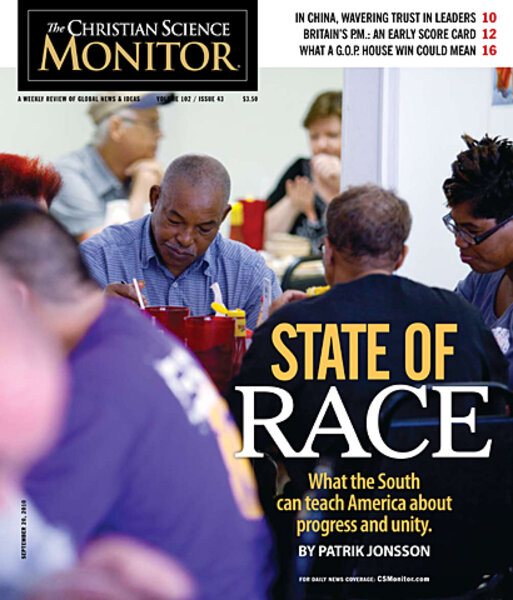Beyond racism: A 'Little Rock Nine' member and civil rights
Loading...
| San Rafael, Calif.
I have been blessed to view America's racial divide from a unique perspective. I grew up in Little Rock, Ark., during the 1950s – an oppressed child whose entire world was filled with visibly frightened black people fenced into the grind of powerlessness.
At 12, I hardly knew what to wish for, or dream about. I was drowning in the fear of the adults around me, caged by unwritten rules based on what they thought the white folks wanted and rumors of when the Ku Klux Klan would be riding to our house at night. I was oppressed because I couldn't walk down the street when I wanted, or shop in department stores, or eat at the lunch counter of the five-and-dime. Above all, I couldn't get a seat in the chariot to view the front of life – never mind the front of the bus.
As I read about white celebrities in movie magazines; famous black stars in Ebony; and slick, polished girls in Seventeen, I was ready for something that amounted to much more than I'd ever imagined for myself.
At 16 I got my opportunity: Partly by luck, but also because I went to church every Sunday, made excellent grades, and had a pristine behavior record, I was chosen to be a significant player in the civil rights movement.
I am one of the Little Rock Nine, one of the teenagers who integrated all-white Central High School in 1957. We sparked such a national firestorm that President Eisenhower summoned the Army to guard us as we entered the school amid a mob threatening to lynch us. We were nine black kids joining 1,900 white students – and they weren't mounting any welcome wagon for us.
As a high school sophomore I suddenly had a bounty on my head: The local white citizens' council offered $10,000 for me dead; $5,000 alive. As a result, I was rushed to the airport by my family and ushered onto a plane bound for California. There I found the haven where I began to develop my own conclusions about race in America.
To my surprise, the family who volunteered to the National Association for the Advancement of Colored People to give me shelter was white: Dr. and Mrs. George McCabe and their four children. They cared for me as if I were one of their own. Above all, they opened my thought and heart to possibilities. I watched as my adopted father, a college professor earning a modest living, demonstrated what is possible to those who are free to pursue their dreams – he founded a university from scratch.
Compared with what my birth parents were able to do, this seemed like magic to me.
As years passed, I realized that the McCabes were a part of a process that would prepare me to chase my own dreams, equality, and dignity with determination, whether I got it immediately or not.
It is this seeking process that ultimately leads to the erosion of the great racial divide: It is the way the civil rights movement has moved most of America from the behavior of a mean-spirited, selfish toddler to a curious adolescent, willing to keep an open mind and struggle for the often-delayed gratification of change.
I've come to believe that racial disharmony is sparked by a single thing: the individual's search for equality, dignity, and acknowledgment by others. In my experience, fighting for my own equality, I've concluded that the civil rights movement served us all because it created a more level field for interaction, one where everyone has a greater opportunity to pursue, acquire, and sustain personal equality.
Certainly many people are still denied their rights to equal opportunity for education, jobs, marriage, housing, and other needs. But it was the dignity of Martin Luther King's dream that forever grants permission to others, who might never have had one, to grow their own.
Now every black baby born in the 'hood, every Latino baby born in the barrio, and every gay baby born in the burbs can dream of claiming their equality, too. It is the nature of this dream – the depth and breadth of it – that shapes and fuels evolution of the civil rights movement in modern America.
We are without a doubt better off than we were in 1957, as far as race relations go. Certainly race relations are not perfect, and, to make things even more complex, the racial divide no longer encompasses only black and white because we are a tapestry of different races and religions. But because more of us now can see exactly what we want, more of us can now define what our individual equality might look like. It is something we couldn't do before we expressed our grief, anger, and sometimes deadly violence in the civil rights movement.
But we have an African-American president – and that has defined a bit of what my own equality looks like. This man of mixed racial heritage has brought light that helps us glimpse equality where it may not have been visible before. And seeing equality helps us be equal.
• Melba Patillo-Beals, one of the Little Rock Nine who integrated all-white Central High School in 1957, chairs the communication department at Dominican University of California, in San Rafael. She is the author of "Warriors Don't Cry."





